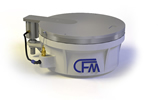|
The membrane air spring works by the principle of an enclosed air volume in a reservoir, sealed with a rubber membrane. On top of the membrane, the air spring load plate carries the object that has to be isolated. With rising pressure inside the air reservoir, the force on the membrane increases as well. If this force is greater than the force caused by the weight of the object, the membrane arches upwards and lifts the object. The advantages of membrane air springs are the high horizontal spring stiffness and variable air damping that is adjustable by a throttle valve.
The membrane air springs type -C include the level control valve. Air Springs of Type -CPC comprise of the level control valve and an electronic position indicator.
At the MAS membrane air springs –ZV1 and – ZV2 the vertical natural frequency is reduced by increasing the air volume of the air spring.
| APPLICATION |
|
| passive vibration isolation |
active vibration isolation |
| -
metrological devices |
-
machines* |
| -
electron microscopes |
-
engine test rigs* |
| -
laser technology equipment |
-
transmission test rigs* |
| -
measurement setups |
|
| |
* = with low dynamics |
|




